Formula One engines
Since its inception in 1947, Formula One has used a variety of engine regulations. "Formulae" limiting engine capacity had been used in Grand Prix racing on a regular basis since after World War I. The engine formulae are divided according to era.
| Formula One |
|---|
|
Current season |
|
Lists |
|
Records |
Operation
Formula One currently uses 1.6 litre four-stroke turbocharged 90 degree V6 Double-overhead camshaft (DOHC) reciprocating engines.[1] They were introduced in 2014 and have been modified over the past seasons.
The power a Formula One engine produces is generated by operating at a very high rotational speed, up to 15,000 revolutions per minute (rpm).[2] This contrasts with road car engines of a similar size which typically operate at less than 6,000 rpm. The basic configuration of a naturally aspirated Formula One engine had not been greatly modified since the 1967 Cosworth DFV and the mean effective pressure had stayed at around 14 bar MEP.[3] Until the mid-1980s Formula One engines were limited to around 12,000 rpm due to the traditional metal valve springs used to close the valves. The speed required to operate the engine valves at a higher rpm called for ever stiffer springs, which increased the power loss to drive the camshaft and the valves to the point where the loss nearly offset the power gain through the increase in rpm. They were replaced by pneumatic valve springs introduced by Renault,[4][5] which inherently have a rising rate (progressive rate) that allowed them to have extremely high spring rate at larger valve strokes without much increasing the driving power requirements at smaller strokes, thus lowering the overall power loss. Since the 1990s, all Formula One engine manufacturers used pneumatic valve springs with the pressurised air allowing engines to reach speeds of over 20,000 rpm.[5][6][7]
Short stroke engine
Formula One cars use short stroke engines.[8] To operate at high engine speeds, the stroke must be relatively short to prevent catastrophic failure, usually from the connecting rod, which is under very large stresses at these speeds. Having a short stroke means a relatively large bore is required to reach a 1.6 litre displacement. This results in a less efficient combustion stroke, especially at lower rpm.
In addition to the use of pneumatic valve springs a Formula One engine's high rpm output has been made possible due to advances in metallurgy and design, allowing lighter pistons and connecting rods to withstand the accelerations necessary to attain such high speeds. Improved design also allows narrower connecting rod ends and so narrower main bearings. This permits higher rpm with less bearing-damaging heat build-up. For each stroke, the piston goes from a virtual stop to almost twice the mean speed (approximately 40 m/s), then back to zero. This occurs once for each of the four strokes in the cycle: one Intake (down), one Compression (up), one Power (ignition-down), one Exhaust (up). Maximum piston acceleration occurs at top dead center and is in the region of 95,000 m/s2, about 10,000 times standard gravity (10,000 g).
History
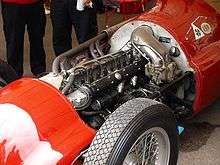
Formula One engines have come through a variety of regulations, manufacturers and configurations through the years.[9]
1947–1953
This era used pre-war voiturette engine regulations, with 4.5 L atmospheric and 1.5 L supercharged engines. The Indianapolis 500 (which was a round of the World Drivers' Championship from 1950 onwards) used pre-war Grand Prix regulations, with 4.5 L atmospheric and 3.0 L supercharged engines. The power range was up to 425 hp (317 kW), though the BRM Type 15 of 1953 reportedly achieved 600 hp (447 kW) with a 1.5 L supercharged engine.
In 1952 and 1953, the World Drivers' Championship was run to Formula 2 regulations, but the existing Formula One regulations remained in force and a number of Formula One races were still held in those years.
1954–1960
Naturally-aspirated engine size was reduced to 2.5 L and supercharged cars were limited to 750 cc. No constructor built a supercharged engine for the World Championship. The Indianapolis 500 continued to use old pre-war regulations. The power range was up to 290 hp (216 kW).
1961–1965
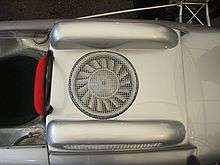
Introduced in 1961 amidst some criticism, the new reduced engine 1.5 L formula took control of F1 just as every team and manufacturer switched from front to mid-engined cars. Although these were initially underpowered, five years later average power had increased by nearly 50% and lap times were better than in 1960. The old 2.5 L formula had been retained for International Formula racing, but this didn't achieve much success until the introduction of the Tasman Series in Australia and New Zealand during the winter season, leaving the 1.5 L cars as the fastest single seaters in Europe during this time. The power range was between 150 hp (112 kW) and 225 hp (168 kW).
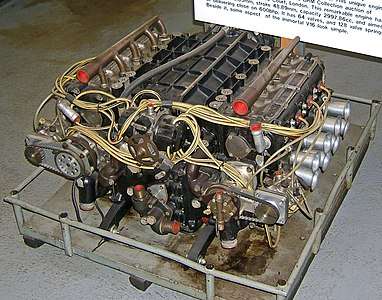
1966–1986
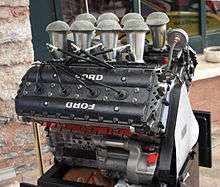
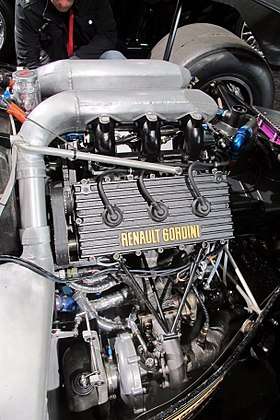
In 1966, with sports cars capable of outrunning Formula 1 cars thanks to much larger and more powerful engines, the FIA increased engine capacity to 3.0 L atmospheric and 1.5 L compressed engines. Although a few manufacturers had been clamouring for bigger engines, the transition wasn't smooth and 1966 was a transitional year, with 2.0 L versions of the BRM and Coventry-Climax V8 engines being used by several entrants. The appearance of the standard-produced Cosworth DFV in 1967 made it possible for small manufacturers to join the series with a chassis designed in-house. Compression devices were allowed for the first time since 1960, but it wasn't until 1977 that a company actually had the finance and interest of building one, when Renault debuted their new Gordini V6 Turbo at the British Grand Prix at Silverstone that year. In 1980 Renault proved that turbocharging was the way to go in order to stay competitive in Formula One (particularly at high-altitude circuits like Kyalami in South Africa and Interlagos in Brazil); this engine had a considerable power advantage against the Ford-Cosworth DFV, Ferrari and Alfa Romeo naturally aspirated engines. Following this, Ferrari introduced their all-new turbocharged engine in 1981. Following these developments, Brabham owner Bernie Ecclestone managed to get BMW to make the team turbocharged inline-4 engines from 1982 onwards. And in 1983, Alfa Romeo made a turbocharged V8 engine, and in the same year and following years, Honda, Porsche (badged as TAG), Ford-Cosworth and other smaller companies made turbo-charged engines, mostly twin-turbocharged V6's. By the midpoint of 1985, every competing team had a turbocharged engine in their car. By 1986, power figures were reaching unprecedented levels, with all engines reaching over 1,000 hp during qualifying with unrestricted turbo boost pressures; This was especially seen with the BMW engines of Benetton's cars, reaching around 1,350 hp at a 5.5 bar boost pressure during qualifying. However, these engines & gearboxes were very unreliable because of the engine's immense power, and would only last about four laps. For the race, the turbocharger's boost was restricted to ensure engine reliability; But, the engines still produced 850–1,000 hp during the race. The power range from 1966 to 1986 was between 285 hp (210 kW) to 500 hp (370 kW), turbos 500 hp (370 kW) to 900 hp (670 kW) in race, in qualifying up to 1,350 hp (1,010 kW). Following their experiences at Indianapolis, in 1971 Lotus made a few unsuccessful experiments with a Pratt & Whitney turbine fitted to chassis which also had 4WD.
1987–1988
Following the turbo domination, forced induction was allowed for two seasons before its eventual ban. The FIA regulations limited boost pressure, to 4 bar in qualifying in 1987 for 1.5 L turbo; and allowed a bigger 3.5 L formula. These seasons were still dominated by turbocharged engines, the Honda RA167E V6 supplying Nelson Piquet winning the 1987 Formula One season on a Williams also winning the constructors championship, followed by TAG-Porsche P01 V6 in McLaren then Honda again with the previous RA166E for Lotus then Ferrari's own 033D V6.
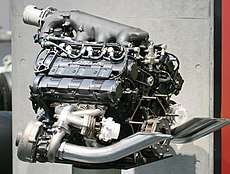
The rest of the grid was powered by the Ford GBA V6 turbo in Benetton, with the only naturally aspirated engine—the DFV-derived Ford Cosworth DFZ 3.5 L V8 outputting 575 hp (429 kW) in Tyrrell, Lola, AGS, March and Coloni.[10] The BMW M12/13 inline-four was found in Brabhams BT55 tilted almost horizontally, and in upright position under the Megatron brand in Arrows and Ligier, producing 900 bhp (670 kW) at 3.8 bar in race.[11] Zakspeed was building its own turbo inline-four, Alfa Romeo was to power the Ligiers with an inline-four but the deal fell through after initial testing had been carried out. Alfa was still represented by its old 890T V8 used by Osella, and Minardi was powered by a Motori Moderni V6.
The 1988 Formula One season was again dominated by turbocharged engines limited to 2.5 bar and Honda with its RA168E turbo V6 producing 640 hp (477 kW) at 12,500 rpm in qualifying, this time with McLaren drivers Ayrton Senna and Alain Prost winning all the grands prix except one won by Ferrari with its 033E V6 with about 650 hp (485 kW) at 12,800 rpm in qualifying. Just behind, Ford introduced its DFR 3.5 L V8 producing 620 hp (462 kW) at 11,000 rpm for Benetton, and the 640 hp (477 kW) Megatron BMW M12/13 was still powering Arrows ahead of the Lotus-Honda. Judd introduced its 600 hp (447 kW) CV 3.5 L V8 for March, Williams and Ligier, and the rest of the grid was mainly using previous year's Ford 590 hp (440 kW) Cosworth DFZ except Zakspeed with their own 640 hp (477 kW) engine and the 700 hp (522 kW) Alfa-Romeo V8 turbo for Osella.
1989–1994
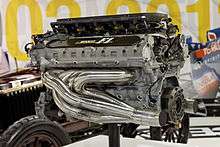
Turbochargers were banned from the 1989 Formula One season, leaving only a naturally aspirated 3.5 L formula. Honda was still dominant with their RA109E 72° V10 giving 675 hp (503 kW) at 13,000 rpm on McLaren cars, enabling Prost to win the championship in front of his teammate Senna. Behind were the Renault RS01 powered Williams, a 67° V10 giving 650 hp (485 kW) at 13,300 rpm. Ferrari with its 035/5 65° V12 giving 660 hp (492 kW) at 13,000 rpm. Behind, the grid was powered mainly by Ford Cosworth DFR V8 giving 620 hp (462 kW) at 10,750 rpm except for a few Judd CV V8 in Lotus, Brabham and EuroBrun cars, and two oddballs: the 620 hp (460 kW) Lamborghini 3512 80° V12 powering Lola, and the 560 hp (420 kW) Yamaha OX88 75° V8 in Zakspeed cars. Ford started to try its new design, the 75° V8 HBA1 with Benetton.
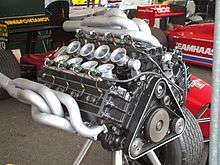
The 1990 Formula One season was again dominated by Honda in McLarens with the 690 hp (515 kW) at 13,000 rpm RA100E powering Ayrton Senna and Gerhard Berger ahead of the 680 hp (507 kW) at 12,750 rpm Ferrari Tipo 036 of Alain Prost and Nigel Mansell. Behind them the Ford HBA4 for Benetton and Renault RS2 for Williams with 660 hp (492 kW) at 12,800 rpm were leading the pack powered by Ford DFR and Judd CV engines. The exceptions were the Lamborghini 3512 in Lola and Lotus, and the new Judd EV 76° V8 giving 640 hp (477 kW) at 12,500 rpm in Leyton House and Brabham cars. The two new contenders were the Life which built for themselves an F35 W12 with three four cylinders banks at 60°, and Subaru giving Coloni a 1235 flat-12 from Motori Moderni

Honda was still leading the 1991 Formula One season in Senna's McLaren with a 710 hp (529 kW) at 13,000 rpm 60° V12 RA121E, just ahead of the Renault RS3 powered Williams benefiting from 700 hp (520 kW) at 12,500 rpm. Ferrari was behind with its Tipo 037, a new 65° V12 giving 710 hp (529 kW) at 13,800 rpm also powering Minardi, just ahead the Ford HBA4/5/6 in Benetton and Jordan cars. Behind, Tyrrell was using the previous Honda RA109E, Judd introduced its new GV with Dallara leaving the previous EV to Lotus, Yamaha were giving its 660 hp (492 kW) OX99 70° V12 to Brabham, Lamborghini engines were used by Modena and Ligier. Ilmor introduced its LH10, a 680 hp (507 kW) at 13,000 rpm V10 which eventually became the Mercedes with Leyton House and Porsche sourced a little successful 3512 V12 to Footwork Arrows; the rest of the field was Ford DFR powered.
In 1992, the Renault engines became dominant, even more so following the departure from the sport of Honda at the end of 1992. Renault won the last three world championships of the 3.5 L formula era with Williams.
By the end of the 1994 season, Ferrari's 043 was putting out 820 hp (611 kW) at 15,800 rpm.[12]
1995–2005
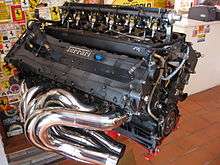
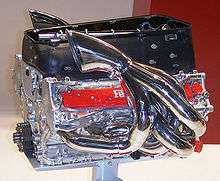
This era used a 3.0 L formula, with a power range between 650 hp (485 kW) and 965 hp (720 kW). Renault was the initial dominant engine supplier from 1995 until 1997, winning the first three world championships with Williams and Benetton in this era. From 1998 to 2000 it was Mercedes power that ruled giving Mika Häkkinen two world championships. Ferrari gradually got better with their engine. For 1996, they changed from their traditional V12 engine to a smaller and lighter V10 engine. They preferred reliability to power, losing out to Mercedes in terms of outright power initially. At the 1998 Japanese GP, Ferrari's 047D engine spec was said to produce over 800 bhp (600 kW). From 2000 they were never short of power or reliability.
BMW started supplying their engines to Williams from 2000. In the first season, the engine was very reliable though slightly short of power compared to Ferrari and Mercedes units. BMW went straight forward with its engine development. The P81, used during the 2001 season, was able to hit 17,810 rpm. Unfortunately reliability was a big issue with several blowups during the season.
The BMW P82, the engine used by the BMW WilliamsF1 Team in 2002, had hit a peak speed of 19,050 revolutions a minute in its final evolutionary stage. It was also the first engine in the 3.0 litre V10-era to break through the 19,000 rpm-wall, during the 2002 Italian Grand Prix's qualifying.[13] BMW's P83 engine used in 2003 season managed an impressive 19,200 rpm and cleared the 900 bhp (670 kW) mark and weighs less than 200 lb (91 kg).[14] Honda's RA003E V10 also cleared the 900 bhp (670 kW) mark at the 2003 Canadian Grand Prix.
In 2005, the 3.0 L V10 engine was permitted no more than 5 valves per cylinder.[15] Also, the FIA introduced new regulations limiting each car to one engine per two Grand Prix weekends, putting the emphasis on increased reliability. In spite of this, power outputs continued to rise. Mercedes engines had about 930 bhp (690 kW) in this season. Renault, Toyota and Ferrari had about 900 bhp (670 kW). BMW had about 950 bhp (710 kW). Honda had about 965 bhp (720 kW).[16]
2006–2013
For 2006, the engines had to be 90° V8 of 2.4 litres maximum capacity with a circular bore of 98 mm (3.9 in) maximum, which implies a 39.8 mm (1.57 in) stroke at maximum bore. The engines must have two inlet and two exhaust valves per cylinder, be normally aspirated and have a 95 kg (209 lb) minimum weight. The previous year's engines with a rev-limiter were permitted for 2006 and 2007 for teams who were unable to acquire a V8 engine, with Scuderia Toro Rosso using a Cosworth V10, after Red Bull's takeover of the former Minardi team did not include the new engines.[17] The 2006 season saw the highest rev limits in the history of Formula One; before a 19,000 rpm mandatory rev limiter was implemented for all competitors in 2007. Cosworth was able to achieve 20,000 rpm with their V8. Honda did the same; albeit only on the dyno.
Pre-cooling air before it enters the cylinders, injection of any substance other than air and fuel into the cylinders, variable-geometry intake and exhaust systems, and variable valve timing were forbidden. Each cylinder could have only one fuel injector and a single plug spark ignition. Separate starting devices were used to start engines in the pits and on the grid. The crankcase and cylinder block had to be made of cast or wrought aluminium alloys. The crankshaft and camshafts had to be made from an iron alloy, pistons from an aluminium alloy and valves from alloys based on iron, nickel, cobalt or titanium. These restrictions were in place to reduce development costs on the engines.[18]
The reduction in capacity was designed to give a power reduction of around 20% from the three-litre engines, to reduce the increasing speeds of Formula One cars. Despite this, in many cases, performance of the car improved. In 2006 Toyota F1 announced an approximate 740 hp (552 kW) output at 18,000 rpm for its new RVX-06 engine,[19] but real figures are of course difficult to obtain.
The engine specification was frozen in 2007 to keep development costs down. The engines which were used in the 2006 Japanese Grand Prix were used for the 2007 and 2008 seasons and they were limited to 19,000 rpm. In 2009 the limit was reduced to 18,000 rpm with each driver allowed to use a maximum of 8 engines over the season. Any driver needing an additional engine is penalised 10 places on the starting grid for the first race the engine is used. This increases the importance of reliability, although the effect is only seen towards the end of the season. Certain design changes intended to improve engine reliability may be carried out with permission from the FIA. This has led to some engine manufacturers, notably Ferrari and Mercedes, exploiting this ability by making design changes which not only improve reliability, but also boost engine power output as a side effect. As the Mercedes engine was proven to be the strongest, re-equalisations of engines were allowed by the FIA to allow other manufacturers to match the power.[20]
2009 saw the exit of Honda from Formula 1. The team was acquired by Ross Brawn, creating Brawn GP and the BGP 001. With the absence of the Honda engine, Brawn GP retrofitted the Mercedes engine to the BGP 001 chassis. The newly branded team won both the Constructors' Championship and the Drivers' Championship from better-known and better-established contenders Ferrari, McLaren-Mercedes, and Renault.
Cosworth, absent since the 2006 season, returned in 2010. New teams Lotus Racing, HRT, and Virgin Racing, along with the established Williams, used this engine. The season also saw the withdrawal of the BMW and Toyota engines, as the car companies withdrew from Formula One due to the recession.[21]
In 2009, constructors were allowed to use kinetic energy recovery systems (KERS), also called regenerative brakes. Energy can either be stored as mechanical energy (as in a flywheel) or as electrical energy (as in a battery or supercapacitor), with a maximum power of 81 hp (60 kW; 82 PS). Four teams used it at some point in the season: Ferrari, Renault, BMW, and McLaren.
Although KERS was still legal in F1 in the 2010 season, all the teams agreed not to use it. KERS returned for the 2011 season, when only three teams elected not to use it. For the 2012 season, only Marussia and HRT raced without KERS, and in 2013 all teams on the grid had KERS. From 2010 to 2013 cars have a regular power of 700–800 hp.
Since 2014
The FIA announced the intention to change the 2.4 litre V8 engines to 1.6 litre V6 turbo engines for the 2014 season. The new regulations include multiple energy recovery systems [22] and fuel flow restrictions, to attract more commercial partners. They sounded very different due to the brand new MGU-H and MGU-K hybrid electric units. A 1.6 litre turbocharged unit was produced to replace the naturally aspirated units.
The new formula reintroduced turbocharged engines, which last appeared in 1988. These have their efficiency improved by turbo-compounding and introduce more energy recovery systems—with power to be harvested from the brakes and exhaust gases.[23] The original proposal for four-cylinder turbocharged engines was not welcomed by the racing teams, in particular Ferrari. Adrian Newey stated during the 2011 European Grand Prix that the change to a V6 enables teams to carry the engine as a stressed member, whereas an inline-4 would have required a space frame. A compromise was reached to adopt V6 turbocharged engines instead.[23] The internal combustion engines are limited to 15,000 rpm, but rarely exceed 12,000 rpm during Grand Prix due to the new reliability and fuel flow restrictions.[24]
Energy recovery systems such as KERS had a boost of 160 hp and 2 megajoules per lap. KERS was renamed Motor Generator Unit–Kinetic (MGU-K). Heat energy recovery systems were also allowed, under the name Motor Generator Unit–Heat (MGU-H)
The 2015 season was an improvement on 2014, adding to most engines about 30–50 hp (20–40 kW), the Mercedes engine being the most powerful with 870 hp (649 kW).
Of the previous suppliers, only Mercedes, Ferrari and Renault produced engines to the new formula in 2014, whereas Cosworth stopped supplying engines. Honda returned in 2015 with their own engine, while McLaren used Honda power changing from Mercedes power in 2014. In 2019, Red Bull switched from using a Renault engine to Honda power. Honda supplies both Red Bull and AlphaTauri.
2022 and beyond
In 2017, the FIA began negotiations with existing constructors and potential new manufacturers over the next generation of engines with a projected introduction date of 2021 but delayed to 2022. The initial proposal was designed to simplify engine designs, cut costs, promote new entries and address criticisms directed at the 2014 generation of engines. It called for the 1.6 L V6 configuration to be retained, but abandoned the complex Motor Generator Unit–Heat (MGU-H) system.[25] The Motor Generator Unit–Kinetic (MGU-K) would be more powerful, with a greater emphasis on driver deployment and a more flexible introduction to allow for tactical use. The proposal also called for the introduction of standardised components and design parameters to make components produced by all manufacturers compatible with one another in a system dubbed "plug in and play".[25] A further proposal to allow four-wheel drive cars was also tabled, with the front axle driven by an MGU-K unit—as opposed to the traditional driveshaft—that functioned independently of the MGU-K providing power to the rear axle, mirroring the system developed by Porsche for the 919 Hybrid sportscar.
Engine specification progression
| Years | Configuration [note 1] |
Maximum displacement | Revolution limit |
Cylinders | Fuel | ||
|---|---|---|---|---|---|---|---|
| Naturally aspirated |
Forced induction |
Methanol | Gasoline | ||||
| 2014–present[note 2] | 4 stroke piston | 1.6 L[note 3][26][27] | 15,000 rpm | 90° V6 | 5.75%[note 4] | High octane unleaded[28] | |
| 2009–2013[note 5] | 2.4 L | Prohibited | 18,000 rpm | 90° V8 | |||
| 2008 | 19,000 rpm | ||||||
| 2007 | Prohibited | ||||||
| 2006[note 6][29] | Unrestricted | ||||||
| 2000–2005 | 3.0 L | V10 | |||||
| 1995–1999 | Up to 12 | ||||||
| 1992–1994 | 3.5 L | ||||||
| 1989–1991 | Unrestricted | ||||||
| 1988 | 1.5 L, 2.5 bar | Unrestricted | |||||
| 1987 | 1.5 L, 4 bar | ||||||
| 1986 | Prohibited | 1.5 L | |||||
| 1981–1985 | 3.0 L | ||||||
| 1966–1980 | Unspecified | ||||||
| 1963–1965 | 1.5 L (1.3 L min.) |
Prohibited | Pump[30] | ||||
| 1961–1962 | Unrestricted | ||||||
| 1958–1960 | 2.5 L | 0.75 L | |||||
| 1954–1957 | Unrestricted | ||||||
| 1947–1953[note 7] | 4.5 L | 1.5 L | |||||
Note:
- 2 stroke, gas turbine, rotary, etc.
- Kinetic (brake) and heat (exhaust) energy recovery systems allowed.
- Naturally aspirated engines are not prohibited, but have not been used by any team. Boost pressure is not limited, but fuel flow rate (which was not regulated up to 2013) is limited to 100 kg per hour (roughly equivalent to 3.5 bar at the maximum rpm).
- 5.75% bio-sourced alcohol content is required in pump-gas.
- Kinetic (braking) energy recovery system (KERS) allowed.
- For 2006 and 2007, the FIA reserved the right to give special dispensations to teams without access to new specification engines to use 2005-spec engines with a rev-limiter. This dispensation was given to Scuderia Toro Rosso in 2006.
- For 1952 and 1953, World Championship races were run to Formula Two rules (0.75 L with compressor, 2 L without), but Formula One regulations remained intact.
Current engine technical specifications
Combustion, construction, operation, power, fuel and lubrication
- Manufacturers: Mercedes-Benz, Renault, Ferrari and Honda
- Type: Hybrid-powered intercooled
- Engine stroke combustion: Four-stroke piston Otto cycle
- Configuration: V6 single hybrid turbocharger engine
- V-angle: 90° cylinder angle
- Displacement: 1.6 L (98 cu in)
- Bore: Maximum 80 mm (3.15 in)
- Stroke: 53 mm (2.09 in)
- Valvetrain: DOHC, 24-valve (four valves per cylinder)
- Fuel: 98–102 RON unleaded gasoline + 5.75% biofuel
- Fuel delivery: Gasoline direct injection
- Fuel injection pressure: 500 bar (7,252 psi; 493 atm; 375,031 Torr; 50,000 kPa; 14,765 inHg)
- Fuel-mass flow restrictor rate: 100 kg/h (220 lb/h) (−40%)
- Fuel economy mileage range: 6 mpg‑US (2.55 km/L)
- Aspiration: Single-turbocharged
- Power output: 875–1,000 + 160 hp (652–746 + 119 kW) @ 15,000 rpm
- Torque: Approx. 400–500 N⋅m (295–369 ft⋅lb)
- Lubrication: Dry sump
- Maximum revs: 15,000 rpm
- Engine management: McLaren TAG-320
- Max. speed: 370 km/h (230 mph) (Monza, Baku and Mexico); 340 km/h (211 mph) normal tracks
- Cooling: Single mechanical water pump feeding a single-front cooling system
- Ignition: High energy inductive
- Banned engine materials: Magnesium based alloys, Metal Matrix Composites (MMCs), intermetallic materials, alloys containing more than 5% by weight of platinum, ruthenium, iridium or rhenium, copper based alloys containing more than 2.75% beryllium, any other alloy class containing more than 0.25% beryllium, tungsten base alloys and ceramics and ceramic matrix composites
Forced induction and push-to-pass
- Turbocharger vendors: Garrett Motion (Ferrari), IHI Corporation (Honda), Mercedes AMG HPP (in-house Mercedes) and Pankl Turbosystems GmbH (Renault)
- Turbocharger weight: 8 kg (18 lb) depending on the turbine housing used
- Turbocharger spin rev limit: 125,000 rpm
- Pressure charging: Single-stage compressor and exhaust turbine, common shaft
- Turbo boost level pressure: Unlimited but mainly typical 4.0 to 5.0 bar (58.02 to 72.52 psi; 3.95 to 4.93 atm; 3,000.25 to 3,750.31 Torr; 400.00 to 500.00 kPa; 118.12 to 147.65 inHg) absolute
- Wastegate: Maximum of two, electronic or pneumatic controlled
ERS systems
- MGU-K RPM: Max 50,000 rpm
- MGU-K power: Max 120 kW
- Energy recovered by MGU-K: Max 2 MJ/lap
- Energy released by MGU-K: Max 4 MJ/lap
- MGU-H RPM: >100,000 rpm
- Energy recovered by MGU-H: Unlimited (> 2 MJ/lap)
Records
Figures correct as of the 70th Anniversary Grand Prix
Bold indicates engine manufacturers that have competed in Formula One in the 2020 season.
World Championship Grand Prix wins by engine manufacturer
^ ** Between 1997–2005 built by Ilmor
^ **** The Indianapolis 500 was part of the World Drivers' Championship from 1950 to 1960.
Most wins in a season
By number
| Rank | Manufacturer | Season | Races | Wins | Percentage | Engine(s) | Winning team(s) |
|---|---|---|---|---|---|---|---|
| 1 | Mercedes | 2016 | 21 | 19 | 90.5% | PU106C Hybrid | Mercedes |
| 2 | Renault | 1995 | 17 | 16 | 94.1% | RS7 | Benetton, Williams |
| Mercedes | 2014 | 19 | 84.2% | PU106A Hybrid | Mercedes | ||
| 2015 | 19 | 84.2% | PU106B Hybrid | Mercedes | |||
| 5 | Ford | 1973 | 15 | 15 | 100% | DFV | Lotus, Tyrrell, McLaren |
| Honda | 1988 | 16 | 93.8% | RA168E | McLaren | ||
| Ferrari | 2002 | 17 | 88.2% | Tipo 050, Tipo 051 | Ferrari | ||
| 2004 | 18 | 83.3% | Tipo 053 | Ferrari | |||
| Mercedes | 2019 | 21 | 71.4% | M10 EQ Power+ | Mercedes | ||
| 10 | Renault | 2013 | 19 | 14 | 73.7% | RS27-2013 | Lotus, Red Bull |
By percentage
| Rank | Manufacturer | Season | Races | Wins | Percentage | Engine(s) | Winning team(s) |
|---|---|---|---|---|---|---|---|
| 1 | Ford | 1969 | 11 | 11 | 100% | DFV | Matra, Brabham, Lotus, McLaren |
| 1973 | 15 | 15 | DFV | Lotus, Tyrrell, McLaren | |||
| 3 | Renault | 1995 | 17 | 16 | 94.1% | RS7 | Benetton, Williams |
| 4 | Honda | 1988 | 16 | 15 | 93.8% | RA168E | McLaren |
| 5 | Ford | 1968 | 12 | 11 | 91.7% | DFV | Lotus, McLaren, Matra |
| 6 | Mercedes | 2016 | 21 | 19 | 90.5% | PU106C Hybrid | Mercedes |
| 7 | Ferrari | 2002 | 17 | 15 | 88.2% | Tipo 050, Tipo 051 | Ferrari |
| 8 | Ferrari* | 1952 | 8 | 7 | 87.5% | Tipo 500, Tipo 375 | Ferrari |
| 9 | Alfa Romeo** | 1950 | 7 | 6 | 85.7% | Tipo 158, Tipo 159 | Alfa Romeo |
| 10 | Mercedes | 2014 | 19 | 16 | 84.2% | PU106A Hybrid | Mercedes |
| 2015 | 19 | 16 | PU106B Hybrid | Mercedes |
* Only Alberto Ascari raced in the 1952 Indianapolis 500 with Ferrari.
** Alfa Romeo did not race in the 1950 Indianapolis 500.
Most consecutive wins
References
- Fédération Internationale de l’Automobile (23 January 2014). "2014 FORMULA ONE TECHNICAL REGULATIONS" (PDF). Retrieved 27 February 2014.
- Engine / gearbox Archived 22 February 2014 at the Wayback Machine Understanding the Sport, Official Formula 1 Website
- F1 Engine Power Secrets, Ian Bamsey, June 2000 RACER magazine
- Scarborough, Craig. "Technically Challenged: Renault Innovations in Formula One" (PDF). Atlas F1. ScarbsF1.com. Archived (PDF) from the original on 24 August 2009. Retrieved 4 June 2012.
- Taulbut, Derek. "Note 89 – TurboCharging background" (PDF). Grand Prix Engine Development 1906 – 2000. Grandprixengines.co.uk. Archived (PDF) from the original on 4 June 2012. Retrieved 4 June 2012.
- https://www.youtube.com/watch?v=_HwHgEWnpfs
- https://www.youtube.com/watch?v=BPdm51QwZEw
- "Why do big diesel engines and race car engines have such different horsepower ratings?". HowStuffWorks. Retrieved 2 April 2014.
- Leo Breevoort; Dan Moakes; Mattijs Diepraam (22 February 2007). "World Championship Grand Prix engine designations and configurations". 6th Gear.
- "STATS F1 • Engines". StatsF1.
- Remi Humbert. "BMW Turbo F1 Engine". Gurneyflap.
- "A Genius Named Todt". Atlasf1.autosport.com. Retrieved 13 February 2011.
- "Williams F1 – BMW P84/85 Engine". F1network.net. Retrieved 13 February 2011.
- Roy McNeill, Copyright BMW World 1999–2005 (22 September 2003). "BMW World – Picture of the Week". Usautoparts.net.
- 2005 Formula One technical regulations Archived 21 June 2006 at the Wayback Machine. FIA
- Honda R&D Technical Review - F1 Special (The Third Era Activities)
- Henry, Alan (ed) (2006). AUTOCOURSE 2006–2007. Crash Media Group. pp. 82–83. ISBN 1-905334-15-X.CS1 maint: extra text: authors list (link)
- 2006 Formula One technical regulations Archived 1 September 2006 at the Wayback Machine, chapter five, 15 December 2005
- F1 technical, Toyota TF106 Specification, 14 January 2006
- "F1 News: FIA agrees to engine re-equalisation". Autosport.com. Haymarket Publications. 22 September 2009. Retrieved 22 September 2009.
- "Are there enough engines in F1 in 2010?". Grandprix.com. Inside F1. Retrieved 2 June 2011.
- "FIA Formula One World Championship Power Unit Regulations". FIA. 29 June 2011.
- Allen, James (20 April 2011). "F1 set for electric only in the pit lane?". JamesallenonF1.com. Retrieved 2 June 2011.
- "Teams are keeping revs under 12000 rpm". Retrieved 11 October 2014.
- https://www.speedcafe.com/2017/11/01/formula-1-unveils-2021-engine-plans/
- "How Formula One's Amazing New Hybrid Turbo Engine Works". 22 January 2014. Retrieved 9 August 2014.
- Fédération Internationale de l’Automobile (23 January 2014). "2014 FORMULA ONE TECHNICAL REGULATIONS" (PDF). Article 5.1 on p.21. Retrieved 12 August 2014.
- "Fuel". formula1. Formula One World Championship Limited. Retrieved 10 April 2017.
- "2006 Formula One Technical Regulations".
- "F1 rules and stats 1960–1969". 1 January 2009. Retrieved 9 August 2014.
External links
| Wikimedia Commons has media related to Formula One engine. |
- Formula One Engines In-depth article covering facts, evolution and tech specs of F1 engines 2009
- Racecar Engineering F1 Engines